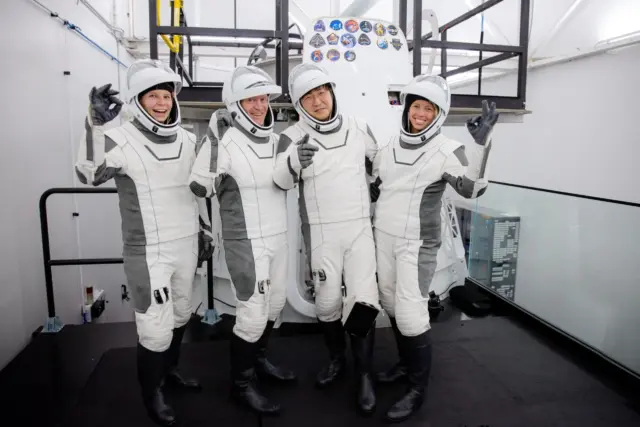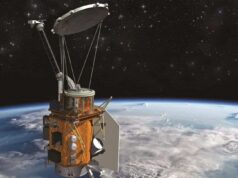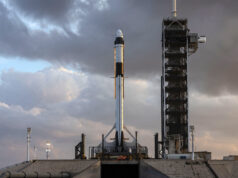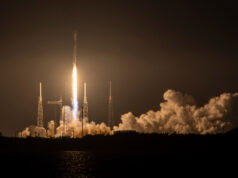
In an audacious feat of engineering and human courage, SpaceX has just etched its name further into the annals of space exploration. The private space company successfully launched four individuals into a polar orbit, a trajectory never before attempted with a crewed mission. This groundbreaking endeavor promises to unlock unprecedented perspectives on our planet and pave the way for new scientific discoveries.
The mission, dubbed “Polaris Dawn II” (a follow-up to a previous high-altitude test flight), lifted off from Cape Canaveral, Florida, at precisely 7:30 AM EDT. A hush fell over the crowd of onlookers as the Falcon 9 rocket, with its Crew Dragon capsule, roared to life, piercing the morning sky with a brilliant plume of fire and smoke. This launch wasn’t just another routine trip to the International Space Station; it was a bold step into uncharted orbital territory.
Why a Polar Orbit for Humans?
Unlike the ISS, which orbits Earth at an inclination of about 51.6 degrees to the equator, a polar orbit passes over or very close to both the North and South Poles on each revolution. This unique trajectory allows for comprehensive coverage of the entire planet over time. Satellites in polar orbits are invaluable for Earth observation, weather forecasting, and military reconnaissance. However, achieving and sustaining a stable polar orbit for a crewed mission presents significant technical challenges, primarily due to the increased energy required to change the spacecraft’s inclination and the need for robust thermal management as the spacecraft experiences vastly different levels of solar exposure.
Meet the Trailblazing Crew
The four individuals aboard the Crew Dragon are not your typical astronauts. Leading the mission is Jared Isaacman, the billionaire entrepreneur who also funded and commanded the first all-civilian orbital mission, Inspiration4. Joining him are seasoned aerospace engineer Dr. Anna Menon, a veteran of multiple SpaceX missions in mission control; pilot Scott Poteet, a retired U.S. Air Force Lieutenant Colonel with extensive test pilot experience; and mission specialist Sarah Gillis, a lead space operations engineer at SpaceX. This diverse crew brings together a wealth of expertise and a shared passion for pushing the boundaries of human spaceflight.
A Mission Packed with Firsts
Polaris Dawn II isn’t just about reaching a new orbit. The mission has several ambitious objectives. The crew will conduct extensive research on the effects of the unique radiation environment in polar regions on the human body. They will also test new spacesuits designed by SpaceX for future spacewalks beyond low Earth orbit. Furthermore, the mission aims to achieve the highest Earth orbit ever flown by humans in a commercial spacecraft and conduct the first commercial spacewalk at such a high altitude.
“This mission represents a significant leap forward in our understanding of what’s possible in human spaceflight,” commented Gwynne Shotwell, President and COO of SpaceX, in a pre-launch press briefing. “Reaching a polar orbit with humans opens up a whole new realm of possibilities for scientific research, Earth observation, and ultimately, our journey to becoming a multi-planetary species.”
The Emotional Toll and the Thrill of Discovery
While the technical aspects of the mission are awe-inspiring, it’s crucial to remember the human element. Strapped atop millions of pounds of thrust, these four individuals are venturing into a frontier where no human has gone before. The psychological and physiological challenges of being in a polar orbit, with its unique day-night cycles and exposure to space radiation, are significant. Yet, the potential for discovery is immense. Imagine the breathtaking views of our planet from these extreme latitudes, the chance to study the Earth’s magnetic field in unprecedented detail, and the sheer thrill of accomplishing something thought impossible just a few years ago.
What Does This Mean for the Future of Space Exploration?
This successful launch has profound implications for the future of space exploration. It demonstrates the increasing capabilities of commercial space companies like SpaceX and their willingness to take on ambitious and challenging missions. A reliable pathway to polar orbits for humans could revolutionize Earth observation, enabling more frequent and detailed monitoring of our planet’s climate, ice caps, and weather patterns. It could also open up new avenues for scientific research in fields like astrophysics and heliophysics.
Moreover, this mission serves as a crucial stepping stone towards more ambitious goals, such as lunar missions and even human missions to Mars. The lessons learned from navigating the complexities of a polar orbit will be invaluable in planning and executing future deep-space voyages.
A Moment of Pride and Inspiration
As the Crew Dragon continues its journey around the Earth, passing over the majestic landscapes of the Arctic and Antarctic, it carries with it the hopes and dreams of millions. This mission is a powerful reminder of humanity’s insatiable curiosity and our relentless pursuit of knowledge. It showcases the incredible power of human ingenuity and the transformative potential of space exploration. This is not just a SpaceX achievement; it’s a moment of pride and inspiration for all of humankind. The data and insights gained from Polaris Dawn II will undoubtedly shape the next chapter of our adventure among the stars.










